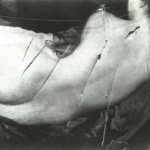 Art inspires emotion. That is its reason for being. But what if those emotions are incomprehensibly negative? What if the inspiration is to destroy?
Art inspires emotion. That is its reason for being. But what if those emotions are incomprehensibly negative? What if the inspiration is to destroy?
No idle speculation, this. A brazen (not to mention expensive) bit of art vandalism occurred just last week, at  the Clyfford Still Museum in Denver. Carmen Tisch (pictured here in what can only be called smug mugshot), physically attacked a 1957 painting by the abstract-expressionist for whom the museum is named. She punched, scratched, and — wait for it — dropped trou and attempted to pee on the painting before being subdued and arrested. As of this writing there’s no known, um, water
the Clyfford Still Museum in Denver. Carmen Tisch (pictured here in what can only be called smug mugshot), physically attacked a 1957 painting by the abstract-expressionist for whom the museum is named. She punched, scratched, and — wait for it — dropped trou and attempted to pee on the painting before being subdued and arrested. As of this writing there’s no known, um, water  damage to 1957-J No. 2, but the surface damage she inflicted is estimated at $10,000. The painting itself was last appraised at between $30 and $40 million.
damage to 1957-J No. 2, but the surface damage she inflicted is estimated at $10,000. The painting itself was last appraised at between $30 and $40 million.
Tisch’s motives remain unknown, although Denver police report she was intoxicated when booked. Drunken vandalism certainly isn’t unusual. Most drunks prefer to take out their aggression on the nearest lamp post, however. Some other factor apparently prompted this drunk into becoming an unusually hands-on art critic.
And that, sadly, isn’t unusual and it isn’t new. Art vandalism has a long and sordid history. Iconic paintings like Da Vinci’s Mona Lisa and Rembrandt’s Night Watch have been attacked several times. Implements of destruction have ranged from knives, hammers and acid; to seemingly innocuous items like pencils, chewing gum and (in one hurled attempt on the Mona Lisa) a terracotta mug.
Da Vinci’s Mona Lisa and Rembrandt’s Night Watch have been attacked several times. Implements of destruction have ranged from knives, hammers and acid; to seemingly innocuous items like pencils, chewing gum and (in one hurled attempt on the Mona Lisa) a terracotta mug.
The motivations for the attacks are just as varied. Mental illness and religious fervor are probably most common (both or either of which might have been the impetus for serial vandal Hans-Joachim Bohlmann, who damaged more than 50 publicly displayed paintings between 1977 and 2006). Unrecognized, unsuccessful artists have also been frequent vandals, lashing out in jealousy; although they’ll often insist they were merely “editing” unworthy or inferior art.
For most, the motivations are as inexplicable as the act. Unlike the casual vandalism with which most of us are more familiar, art vandalism usually requires a fair amount of planning and forethought. When the attack occurs in a museum, as most do, the vandal knows he or she has almost no chance of escape. And yet they go ahead with it.
It’s interesting to note — and it verifies the timelessness of this phenomenon — that the modern usage of the word ‘vandal‘ originally referred to just this sort of destruction. Although we apply it today to any type of willful or petulant defacement, the word vandalisme was coined by the bishop of Blois in 1794, to describe the attacks on artwork concurrent with the French Revolution. He was recalling the Germanic tribe known as the Vandals, whose sack of Rome in the 450s resulted in, you guessed it, the destruction of innumerable classic artworks.
Such timelessness can only mean one thing: art vandalism is with us to stay. Contemporary artists might well shudder at the thought that their work could one day be targeted. But as always, we search painstakingly for the positive: Could it be that vandalism of art brings, backhandedly, some sort of recognition to that art? Maybe. I have to admit that until a few days ago, and even though his work evidently can fetch eight-figure pricetags, I’d never heard of Clyfford Still.